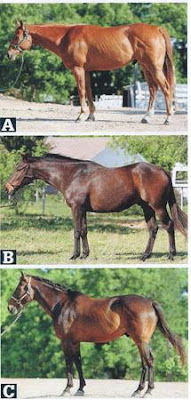4-H Preparation and Presentation of Oral Reasons in Horse Judging Contests.1
L.A. Lawrence and E.L. Johnson
For the horse enthusiast there is no greater compliments than to be called a good judge of quality horses. Generally, the people considered to be good judges have gained their expertise from years of experience in working with horses. While there is no substitute for experience, the Florida Horse Judging Program is designed so that, through study and practice, those interested in horses can gain an appreciation for quality breeding and performance animals. The ultimate goals are to develop basic skills in evaluating horses and then logically and coherently to defend decisions orally.
This publication is designed to be used with the Horse Judging Guide for Florida 4-H Members, which can be obtained from your county Extension office. The presentation of oral reasons seems to cause more difficulty for 4-H members than any other part of the judging contest. This problem area may be dealt with effectively by using 4-H 488, a form for evaluating oral reasons. It is designed for practice by judging coaches, officials, and 4-H members to improve presentation. (A facsimile is reproduced at the end of this publication.) The presentation of oral reasons is the final demonstration of your ability as a judge. In order to present an effective set of oral reasons you must first master the basics of judging.
- Have a mental picture of the ideal horse for the breed type being judged.
- Learn the descriptive terminology used in judging.
- Learn to place horses by comparing individuals.
- Develope a system for judging and taking notes on a class.
- Be able to organize your reasons in a logical sequence and present them effectively without the use of notes
- Be able to relate a mental picture of the class, so that the judge knows you are able to visualize the class clearly
Accuracy and completeness are the two most important components of a set of reason. Together they are worth 60 percent of the total score. Present the major points as accurately as possible, cover completely all important points, but don't get bogged down in detail that is unimportant to the placing of the class.
Proper organization and content of a set of reason begin with taking notes. An outline should be prepared to make note taking easier. The name or number and placing of the class should be given at the top of the page. A system used by many beginners involves dividing the page into three columns- Ideal, Grant, and Fault (Figure 1). The number of the horses should be placed at the left and opposite each number a comparative description of the horse should be recorded in the appropriate column. In the ideal column, list (using abbreviations) the top horse's characteristics that most closely represent the ideal of the breed type.
In the grant column, list the next horse's characteristics that are nearer the ideal than those of the one you have placed first. For example, the No.4 horse may show the most balance, breed type and muscling, but the No.3 horse, which you have placed under him, may have a cleaner throat latch and a trimmer neck. So you would grant that No.3 was cleaner through the throat latch with a longer, trimmer neck tying into the shoulder more correctly. Faults would be the weakness of the No.3 horse which caused you to place him below the No.4 horse. For example, you might have found the No.3 horse lacking balance and muscling and having a short croup and hip. Now proceed through the class, comparing the horses in descending order.
A more advanced system for taking notes requires that you place the horses early in the class. You should have the horses placed during the first go at the walk, trot, and canter in one direction in the performance classes and before close inspection and seeing the horses move in halter classes. Adjustments can be made if major problems are uncovered after the initial placing, but generally your first impression will be the best. Divide the paper into two columns, Comparisons and Grants (Figure 2). Across the page divide it up into three sections. Top Pair, Middle Pair, and Bottom Pair. Take notes using abbreviations for the accepted livestock terms and compare the horses by pairs as you place them. In the grant column list the strengths of the horse placed below the top horse of each pair. Criticism of the top horse should also be listed under the comparison column. This system saves time in that no reorganization of the notes is required when preparing to present your reasons.
Remember to take notes quickly and accurately and be sure to include descriptions of the animals that will help you remember the class. Your notes should include the color and markings of horses and anything about the rider that may help you recall the class. After viewing all the classes you will have some time to prepare your reasons. During this time you should organize all your classes. Master the order in which you will present your reasons and allocate your time appropriately. Practice giving the reason to yourself. (Make sure you do not disturb others by loud recitation.) Finally, use vivid description and describe the class, using comparative terms for the top, middle, and bottom pairs.
When the judge signals you to start, give the name of the class and your placing and then in a confident and persuasive manner paint a picture of the class, as you saw it, for the judge. If you lose lose your place or become flustered, stop, collect your thoughts, and start over as strongly as you began. End your reasons strongly-confident that you have done your best.
Forms for taking notes/Oral Reasons and this article can be found
here


























